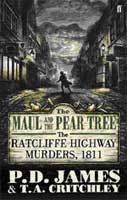
THE MAUL AND THE PEAR TREE
The Ratcliffe Highway Murders, 1811
|
|
THE MAUL AND THE PEAR TREEThe Ratcliffe Highway Murders, 1811 P.D. James & T.A. CritchleyFaber & Faber pbk £7.99Released 4th November 2011Reviewer: Gwen Moffat |
|
Adam Colclough lives and works in the West Midlands, he writes regularly for a number of websites, one day he will get round to writing a book for someone else to review. |
|
On a December night in
1811 a family was murdered on Wapping’s Ratcliffe Highway, London. A
baby, its parents and an apprentice were savagely beaten with a maul and
their throats slashed. A few days latter a publican, his wife and
servant were similarly butchered. There was a panic in London’s docklands, inflamed by the media and a deep-rooted xenophobia. Suspects, often foreigners, were arrested on the flimsiest of excuses, the favoured suspect being one, John Williams, said to be Irish. Found hanging in his cell before committal he was seen as cheating the gallows His corpse was paraded through the streets to be buried at cross-roads with a stake through the heart. Although the Fieldings has founded the Bow Street Runners in 1750 60 years later policing was a farce in Wapping . Nightwatchmen were old, decrepit, and open to bribery from criminals and prostitutes. Crime had long been on the rise, honest magistrates were few compared with those who were incompetent and negligent. After the Wapping murders questions were asked in the House and a committee formed to inquire into the anarchic state of the docklands. Eminent figures such as de Quincey pontificated, (the latter castigated by Roughhead for his “tiresome and frivolous accuracy of memory”), but stagnation was to prevail until 1829 and the formation of the Met. The killers of the Ratcliffe Highway murders were never discovered, nor the motive for the brutality. In the view of James and Critchley John Williams was innocent of the crime although he may have known something of the perpetrators. The authors suggest that, far from being suicide, he was himself a victim. There were other suspects lodged in the same jail and turnkeys could be vulnerable to bribery and intimidation. Williams might have been murdered because he had guilty knowledge or as the fall guy. After he died the investigation was dropped suddenly. Further inquiries could have exonerated him, thus exposing the magistrates as incompetent and bowing to pressure from the mob, the Press, even their superiors. So who was the murder? The authors name a seaman called Abless, probably working with at least one accomplice. This is a fascinating and carefully researched investigation far superior to other attempts to unravel ancient cause célèbres. *A heavy long-handled hammer, used for splitting logs by driving a wedge into it.
|

| Page By Gary Cane [Contact] | ||
| Webmaster: Tony 'Grog' Roberts [Contact] |